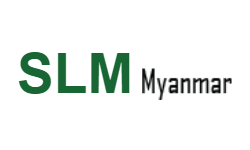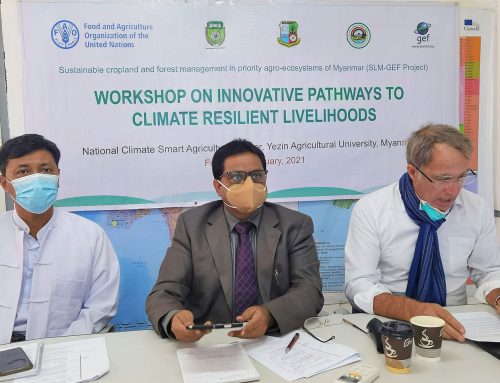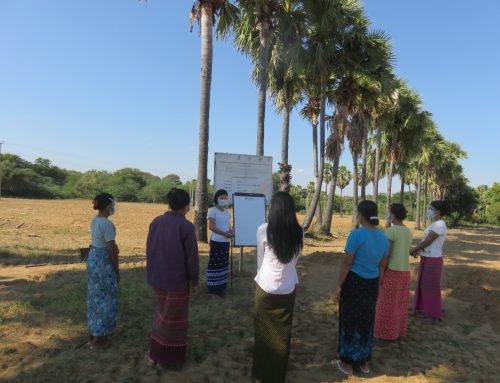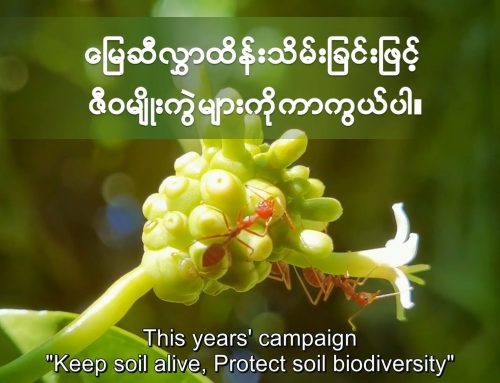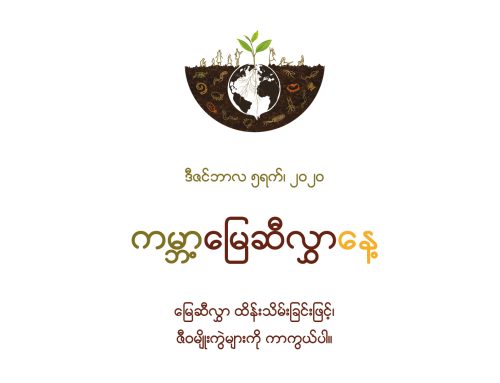 “I tried one acre of rice growing by using climate-smart agriculture (CSA) techniques including System of Rice Intensification (SRI) this year and am planning to expand in five acres in next year” said a village farmer Daw Yin Yin Htay from Loke Taung village in Labutta township.
“I tried one acre of rice growing by using climate-smart agriculture (CSA) techniques including System of Rice Intensification (SRI) this year and am planning to expand in five acres in next year” said a village farmer Daw Yin Yin Htay from Loke Taung village in Labutta township.
A Farmer Field School (FFS) programme is being implemented in 20 villages of Labutta township including Loke Taung village to promote CSA techniques on rice and green gram cultivation. The FFS programme is implemented by an FAO’s project “Sustainable cropland and forest management in priority agro-ecosystems of Myanmar (SLM-GEF)” in collaboration with AVSI and technical support by Department of Agriculture in Labutta township. This village is three miles far from Labutta town. In total there are 30 participants from this village joining FFS who receive regular training on CSA techniques on a monthly basis and also learn practically from a demonstration plot established in the an. Daw Yin Yin Htay is one of the participants in the FFS and she is also the Lead Farmer of the group. She has learnt a lot regarding the CSA practices including SRI technology through this training and she grew one acre of rice by using those techniques.
When the project team asked her experience about CSA and SRI, she explained “I have been growing rice for more than 20 years in my life. Traditionally, we broadcast the rice seed and seed rate for one acre is round about 2.5 to 3 baskets. In SRI, it requires only 12 tins of seed for an acre. It is very cost-effective.” She started using SRI from July 2019 after learning from the FFS demonstration plot. Firstly, germinated seeds are spread on the soil in the frames at the rate of one tin of seeds in six frames. There are totally 72 frames required for planting in one acre. For the fertilizer application, cow dung, compost and organic fertilizers are mainly used and the use of chemical fertilizer is minimized. After about 9-10 days, the seeds are germinated with three tillers which are transplanted in the main field with proper spacing. One and half months later, about 15 tillers can be seen in each plant. After two months, we apply IMO (Indigenous Micro- Organism) to the plants. After three months, the field grows very well and the crop can are after about 120-130 days of transplanting.
 When she started using CSA and SRI, her family was doubtful about the new techniques, especially U Ko Phyu, her father. He is an elite farmer who has been growing rice for more than 60 years. U Bo Phyu said about his experience that “I saw they are planting nine to ten days old seedlings in the field. After they finished transplanting, I went and checked in the filed. The field looked almost empty with only the footprints and tiny plants. I told to my daughter that perhaps this will not work and the crop performance will be very poor. One month later, it grew well and started looking better. Three months later, it looked much better with many tillers in each hill/plant and I didn’t want to look at the other side of the field which was grown using traditional practice.” He also smiled and mentioned about the Department of Agriculture staffs, “Why I didn’t get this kind of technologies earlier, now I am 87”.
When she started using CSA and SRI, her family was doubtful about the new techniques, especially U Ko Phyu, her father. He is an elite farmer who has been growing rice for more than 60 years. U Bo Phyu said about his experience that “I saw they are planting nine to ten days old seedlings in the field. After they finished transplanting, I went and checked in the filed. The field looked almost empty with only the footprints and tiny plants. I told to my daughter that perhaps this will not work and the crop performance will be very poor. One month later, it grew well and started looking better. Three months later, it looked much better with many tillers in each hill/plant and I didn’t want to look at the other side of the field which was grown using traditional practice.” He also smiled and mentioned about the Department of Agriculture staffs, “Why I didn’t get this kind of technologies earlier, now I am 87”.
When we asked about the advantages and disadvantages of using CSA and SRI, Daw Yin Yin Htay explained, “Compared to the traditional way, it is more reliable and cost-effective. The field looks better, healthy paddy plants and less damage. IMO and fish amino acid can also be used to reduce the use of chemical fertilizer. Some practices under CSA such as AWD (Alternate Wetting and Drying) fire trap and rotatory weeder are also applied. One of the downsides is that we need to protect from the mice at the stage of preparation for nursery raising. To increase the income and reduce the expense, we have to face such minor weaknesses. In the future, I will grow the paddy with SRI technologies in all my land.”
Growing paddy with SRI in combination with the use of some other CSA practices (IMO, fish amino acid, fire trap, AWD and rotary weeder) are highly beneficial to the farmers as compared with the traditional practices. While the total cost of seeds for one acre will be around 23,000 kyats (between 2.5 and 3 basket cost) in the traditional way it will be only 800 kyats (12 tins cost) in SRI. Moreover, the yield per acre is also different with 58 baskets from traditional way and 73 baskets from SRI. Therefore, the net income is increased by the use of SRI method and other CSA techniques with the higher yield and by less use of expensive chemical fertilizers and other inputs. It is one of the climate-smart agriculture good practices which need to be upscaled widely. Not only Daw Yin Yin Htay but other farmers in the Loke Taung village and other FFS villages in Labutta township are highly convinced to use SRI and other CSA techniques and are willing to expand the area as much as they can.
